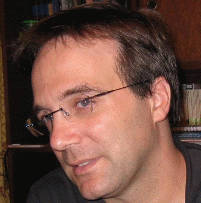 14/07/2017, 17:30 — 18:30 — Anfiteatro Pa1, Pavilhão de Matemática
14/07/2017, 17:30 — 18:30 — Anfiteatro Pa1, Pavilhão de Matemática
Daniel Abreu, Austrian Academy of Sciences
The music of the electrons: time-frequency analysis meets statistical mechanics.
At a first glance it may be hard to tell what musical scores and electron density wave functions have in common, but mathematicians can perceive both as the same object. Such a seemingly bizarre assertion can be better understood in the formulation of uncertainty principles (UPs). UPs tell us that it is impossible to simultaneously measure the position and momentum of an electron and, in time-frequency analysis, that it is impossible to hear an instantaneous frequency. To overcome such obstructions, electron density wave functions are written as functions of position and momentum, while music signals are written as functions of time and frequency (as in a musical score). In this talk we will see how, in mathematics:
- UPs boil down to the fact that a nonzero function and its Fourier transform cannot both be supported in arbitrary small sets (a simple consequence of Cauchy-Schwarz inequality).
- The model behind electron density wave functions and time-frequency representations is essentially the same.
- The identification of the two models has recently led to several new results in the analysis of the Landau equation with a magnetic field and the statistics of multi-layer electron distributions.
 14/07/2017, 16:00 — 17:00 — Anfiteatro Pa1, Pavilhão de Matemática
14/07/2017, 16:00 — 17:00 — Anfiteatro Pa1, Pavilhão de Matemática
Rita Ferreira, KAUST
A chromaticity-brightness model for color images denoising
In this talk, we address an imaging processing problem aimed at denoising colored images using a “$u+v$” model as in [Me] coupled with a chromaticity-brightness decomposition approach as in [KaMa]. It amounts to solve a minimization problem associated with energy integral functionals depending on a small parameter $\varepsilon \gt 0$. The asymptotic behavior as $\varepsilon \to 0^+$ is characterized, and convergence of infima, almost minimizers, and energies are established. In particular, an integral representation of the lower semicontinuous envelope, with respect to the $L^1$-norm, of functionals with linear growth and defined for maps taking values on a certain manifold is provided. This study escapes the realm of previous results since the underlying manifold has boundary, and the integrand and its recession function fail to satisfy hypotheses commonly assumed in the literature. This is a joint work with Irene Fonseca (Carnegie Mellon University, Pittsburgh, USA) and M. Luísa Mascarenhas (Faculdade de Ciências e Tecnologia - UNL, Lisbon, Portugal).
- [KaMa] S.H. Kang and R. March, Variational Models for Image Colorization via Chromaticity and Brightness Decomposition, IEEE Trans. Image Process. 16 (9), 2251-2261 (2007).
- [Me] Y. Meyer, Oscillating Patterns in Image Processing and Nonlinear Evolutions Equations. The Fifteenth Dean Jacqueline B. Lewis Memorial Lectures, University Lecture Series, Vol. 22, Amer. Math. Soc., 2001.
Ver também
RF_s.pdf
 14/07/2017, 15:00 — 16:00 — Anfiteatro Pa1, Pavilhão de Matemática
14/07/2017, 15:00 — 16:00 — Anfiteatro Pa1, Pavilhão de Matemática
Diogo Oliveira e Silva, University of Bonn
From Kakeya to Restriction, and how to make it sharp
What is the smallest area which is required to rotate a unit line segment by 180 degrees in the plane? How is the geometric notion of curvature related to the analytic notion of decay? What can be said about the convergence of Fourier series in higher dimensions? And, perhaps more interestingly, how are these apparently unrelated questions connected?
In this talk, we will provide a short introduction to the Kakeya problem, the Fourier restriction problem, and the Bochner-Riesz problem, highlighting the various interdependences. We will then focus on some recent progress on sharp Fourier restriction theory on spheres, hyperboloids and perturbed paraboloids, and describe some applications.
Ver também
DOS_s.pdf
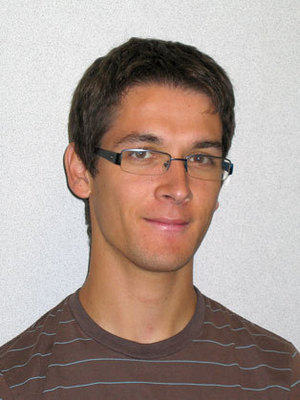 14/07/2017, 11:00 — 12:00 — Anfiteatro Pa1, Pavilhão de Matemática
14/07/2017, 11:00 — 12:00 — Anfiteatro Pa1, Pavilhão de Matemática
Joel Moreira, Northwestern University
Monochromatic sums and products
Is it possible to color the natural numbers with finitely many colors, so that whenever $x$ and $y$ are of the same color, their sum $x+y$ has a different color? A 1916 theorem of I. Schur tells us that the answer is *no*. In other words, for any finite coloring of $\mathbb{N}$, there exist $x$ and $y$ such that the triple $\{x,y,x+y\}$ is monochromatic (i.e. all terms have the same color). A similar result holds if one replaces the sum $x+y$ with the product $xy$, however, it is still unknown whether one can finitely color the natural numbers in a way that no quadruple $\{x,y,x+y,xy\}$ is monochromatic!
A recent partial solution to this problem states that any finite coloring of the natural numbers yields a monochromatic triple $\{x,x+y,xy\}$. In order to present the main ideas underlying this proof, I will review some classical results in Ramsey theory and explain how ergodic theory and dynamical systems can be used to answer questions in that field.
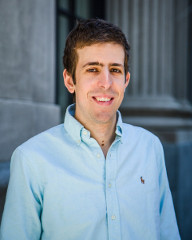 14/07/2017, 09:30 — 10:30 — Anfiteatro Pa1, Pavilhão de Matemática
14/07/2017, 09:30 — 10:30 — Anfiteatro Pa1, Pavilhão de Matemática
Afonso Bandeira, New York University
Statistical estimation under group actions: The Sample Complexity of Multi-Reference Alignment
Many problems in signal/image processing, and computer vision amount to estimating a signal, image, or tri-dimensional structure/scene from corrupted measurements. A particularly challenging form of measurement corruption are latent transformations of the underlying signal to be recovered. Many such transformations can be described as a group acting on the object to be recovered. Examples include the Simulatenous Localization and Mapping (SLaM) problem in Robotics and Computer Vision, where pictures of a scene are obtained from different positions and orientations; Cryo-Electron Microscopy (Cryo-EM) imaging where projections of a molecule density are taken from unknown rotations, and several others.
One fundamental example of this type of problems is Multi-Reference Alignment: Given a group acting in a space, the goal is to estimate an orbit of the group action from noisy samples. For example, in one of its simplest forms, one is tasked with estimating a signal from noisy cyclically shifted copies. We will show that the number of observations needed by any method has a surprising dependency on the signal-to-noise ratio (SNR), and algebraic properties of the underlying group action. Remarkably, in some important cases, this sample complexity is achieved with computationally efficient methods based on computing invariants under the group of transformations.
We will also discuss the sample complexity of the heterogeneous multi-reference alignment problem where the samples come from a mixture of signals, and provide the first known procedure that provably achieves signal recovery in the low SNR regime. A related problem is heterogenous reconstruction in Cryo-Electron Microscopy (Cryo-EM) imaging where multiple unknown molecules or molecules in multiple unknown conformations are imaged together. Our work can be seen as a first step towards a complete statistical theory of heterogenous Cryo-EM.
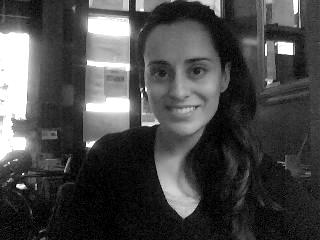 13/07/2017, 17:30 — 18:30 — Anfiteatro Abreu Faro, Complexo Interdisciplinar
13/07/2017, 17:30 — 18:30 — Anfiteatro Abreu Faro, Complexo Interdisciplinar
Inês Henriques, University of Sheffield
Test, Invariant and multiplier ideals
As a measure of singularities of a scheme $X$, we study the log-canonical threshold, defined over the complex numbers in terms of integrability, or over any field of characteristic $0$ in terms of resolution of singularities.
In positive characteristic, one can define the $F$-pure threshold in terms of the Frobenius endomorphism. Quite surprisingly, these two different ways of quantifying singularities are intimately related: If the equations defining $X$ have integral coefficients, then the $F$-pure threshold of the reduction of $X$ modulo a prime number $p$ approaches the $\log$-canonical threshold of $X$ as $p$ goes to infinity.
We will discuss basic properties of these invariants in terms of the corresponding multiplier and test ideals, and present work done with Matteo Varbaro, on the multiplier ideals of $G$-stable projective subschemes of $\operatorname{Proj}(\operatorname{Sym}(E))$, when $E$ is the tensor product between $2$ finite vector spaces $V$ and $W$ over a field of characteristic $0$, and $G = \operatorname{GL}(V) \times \operatorname{GL}(W)$. The proof, quite surprisingly relies on a reduction to the context of positive characteristic, where $G$-stable subschemes are not well-understood!
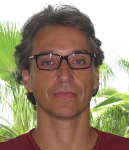 13/07/2017, 16:00 — 17:00 — Anfiteatro Pa1, Pavilhão de Matemática
13/07/2017, 16:00 — 17:00 — Anfiteatro Pa1, Pavilhão de Matemática
Bruno de Oliveira, University of Miami
The geometry of symmetric differentials
Complex manifolds have an array of intrinsic tensors. They provide us with geometric notions with fascinating connections to fundamental algebraic, topological and arithmetic properties. Intrinsic tensors include symmetric differentials which are sections of the symmetric powers of the cotangent bundle. We will discuss three aspects of the algebra of symmetric differentials on projective manifolds. Topology: the mysterious relation between the fundamental group and the algebra of symmetric differentials. Intrinsic analytic and arithmetic geometry: obstructions to the existence of special subvarieties (e.g. rational and elliptic curves). Extrinsic geometry and algebraic properties: submanifolds of low codimension in projective space have no holomorphic symmetric differentials. We describe for low codimensions what is the geometry and the algebraic properties associated to the non-vanishing algebra of symmetric differentials whose poles are of the lowest possible order.
Ver também
BO_s.pdf
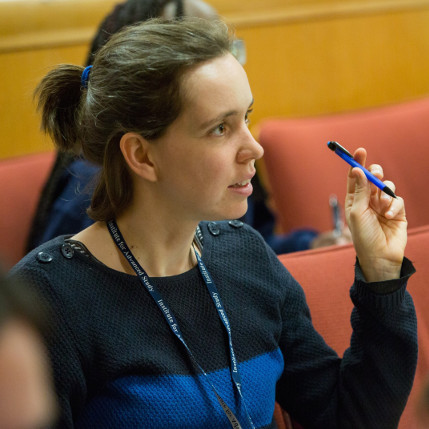 13/07/2017, 15:00 — 16:00 — Anfiteatro Pa1, Pavilhão de Matemática
13/07/2017, 15:00 — 16:00 — Anfiteatro Pa1, Pavilhão de Matemática
Ana Rita Pires, Fordham University
Symplectic embedding problems and infinite staircases
When doing a sphere packing, what is the biggest proportion of the space that can be filled by spheres? The answer depends on how we can deform those spheres: Euclidian packings are the most rigid, whereas volume preserving packings are the most flexible. Symplectic packings fall in the middle, with a mix of rigid and flexible behavior.
In this talk we will relate this question to the more general problem of symplectically embedding ellipsoids into the smallest possible scaling of a target manifold. We will also see how the answer involves infinite staircases, Fibonacci numbers and other recursive sequences, and counting lattice points on triangles.
Ver também
ARP_s.pdf
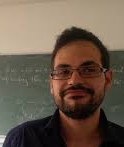 13/07/2017, 11:00 — 12:00 — Anfiteatro Pa1, Pavilhão de Matemática
13/07/2017, 11:00 — 12:00 — Anfiteatro Pa1, Pavilhão de Matemática
Marco Robalo, Université Pierre et Marie Curie
Derived Algebraic Geometry & Gromov-Witten invariants
Algebraic Geometry and commutative algebra are symbiotic. However, this interaction is not perfect when addressing singular spaces and non-transverse intersections. Derived Algebraic Geometry results from the discovery that this symbiosis becomes perfect if commutative algebra is enhanced with techniques of homotopy theory. We will give a brief introduction to derived algebraic geometry and explain its applications to Gromov-Witten theory.
Ver também
MR_s.pdf
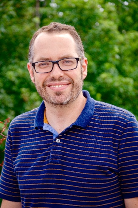 13/07/2017, 09:30 — 10:30 — Anfiteatro Pa1, Pavilhão de Matemática
13/07/2017, 09:30 — 10:30 — Anfiteatro Pa1, Pavilhão de Matemática
André Neves, University of Chicago
Weyl Law for volume spectrum
The volume spectrum was introduced by Gromov in the 70’s. Recently, with Liokumovich and Marques, we proved a Weyl Law for the volume spectrum that was conjectured by Gromov.
I will talk about how a better understanding of the volume spectrum would help answering some well known questions for minimal surfaces or volume of nodal sets.
Ver também
AN_s.pdf
